Brazil is known to have a diverse ecosystem with the Amazon rainforest. As a result, it contains one of the most diverse populations of bird species. These birds are fascinating with their physical characteristics, behavior patterns, and just in all their species as a whole.
Over 3,000 species of birds reside within Brazil’s forests and other areas. They are magnificent creatures like the Toucan, Burrowing Owl, and more! You will find everything you need to know about the most beautiful birds you should see if you decide to visit Brazil.
Burrowing Owl
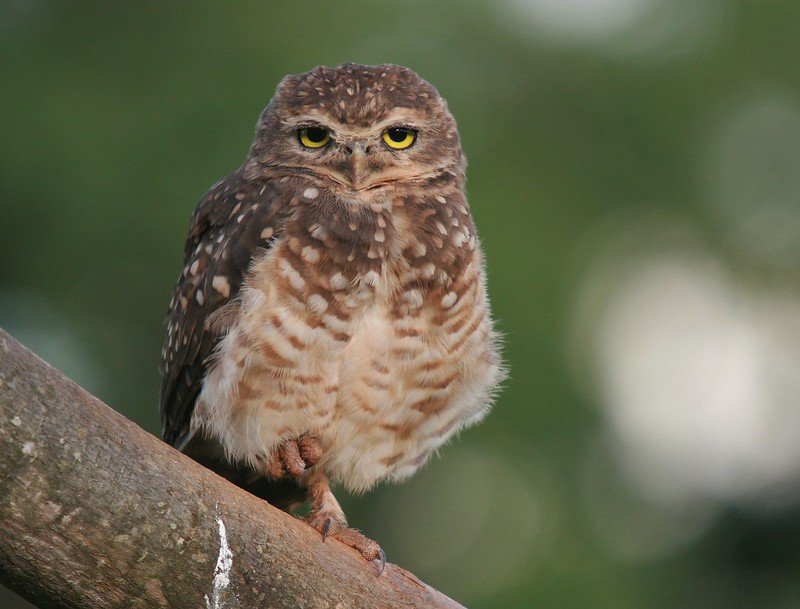
If you have ever seen the movie “Hoot,” you have some idea of a Burrowing Owl. They live in a wide area of both North and South America but are still endangered due to the loss of their habitat.
Physical Features And Other Characteristics
Unlike many other owl breeds, these are smaller with long legs. They have a small disc-like face with tans and browns. Their beaks are a greyish olive and prominent white eyebrows over yellow eyes.
These little creatures are carnivorous, feeding on small rodents, but they also have many predators after them: other owls, hawks, falcons, eagles, badgers, skunks, and ferrets. Unfortunately, they are often killed by vehicles because they live mainly on the ground, so their mortality is about nine years in the wild and 10 in captivity.
Location And Environment
Burrowing Owls are spread across Midwest North America, the majority of Central America, and South America. When you are in Brazil, most Burrowing Owls live in the southern half.
They live in mainly open, dry grassland due to their colonies burrowing beneath the ground. They will sometimes live alone, but you will often find them in loose colonies. They like to perch on dirt mounds or fence posts to view their surroundings better.
Fun Fact
Besides spending most of their time on the ground, these creatures tend to be monogamous, meaning they stick with one partner. Now and then, you will find a male Burrowing Owl may discover a second female partner, but they do generally not have more than two partners.
This species of owl also is known to be very vocal. They use many different calls like an alarm system for various purposes. For example, younger Burrowing Owls will mimic the hiss of a rattlesnake when the next is disturbed to attract the adults and chase away any intruders.
Hyacinth Macaw
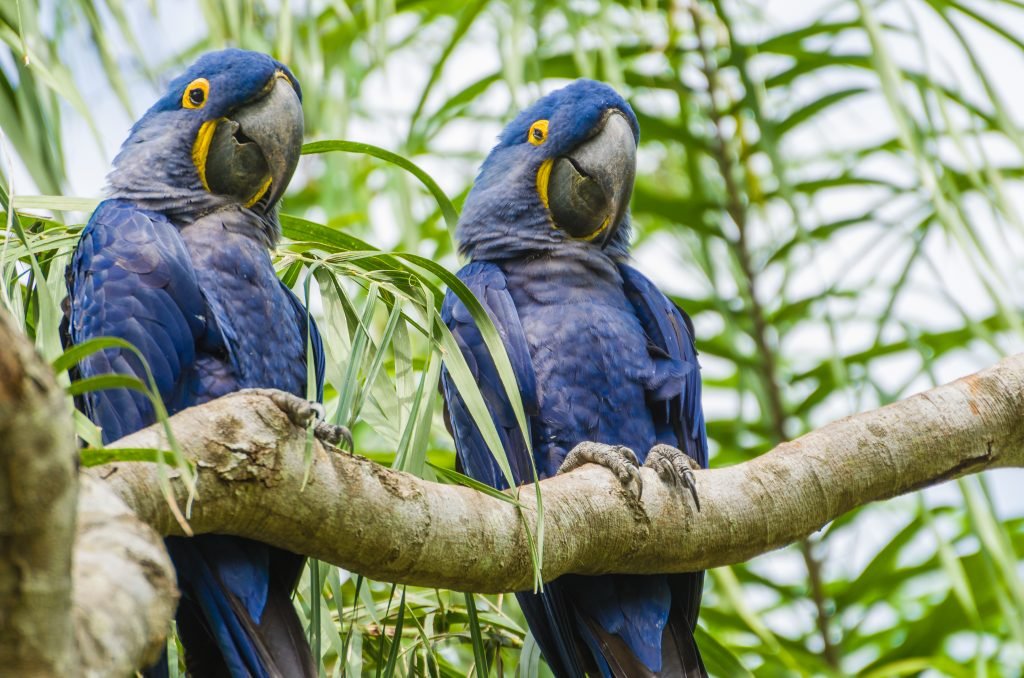
The Hyacinth Macaw is one of Brazil’s most beautiful bird species. Sadly they are considered “vulnerable” as the continuation of destroying their ecosystem has caused a decline in their population.
Physical Features And Other Characteristics
The Hyacinth Macaw can quickly be identified with its striking cobalt blue feathers. It also doesn’t help that they are massive in size and can easily be spotted due to this characteristic. They’ve been called the “Gentle Giant.” It contains a bit yellow at the corners of its beak and around the eyes.
These birds can become quite destructive when they get bored and need much free time or space to roam. If they don’t get this, they will become cranky, and you don’t want them taking it out on you. They can be pretty stubborn like many within this species.
Location And Environment
You can easily spot them in their natural habitat on the outskirts of the rainforests or grasslands. However, they like to reside in places with a little of both. This means they are found more north or south-central Brazil.
Deforestation, poaching, and hunting have been a big reason their environment and location have dwindled. They eat from a specific type of palm tree, so they live close to their food source.
Fun Fact
The Hyacinth Macaw develops much slower than other species of birds like it. They don’t fully mature into adulthood until about almost a year. Then, they don’t even start breeding until they are about seven years old!
With their slow developmental growth, it is no wonder that these birds can live to about 60 years if cared for properly. They can be your partner for your entire life if you want and can be a great companion once you get used to their big personality and expensive care.
Saffron Toucanet
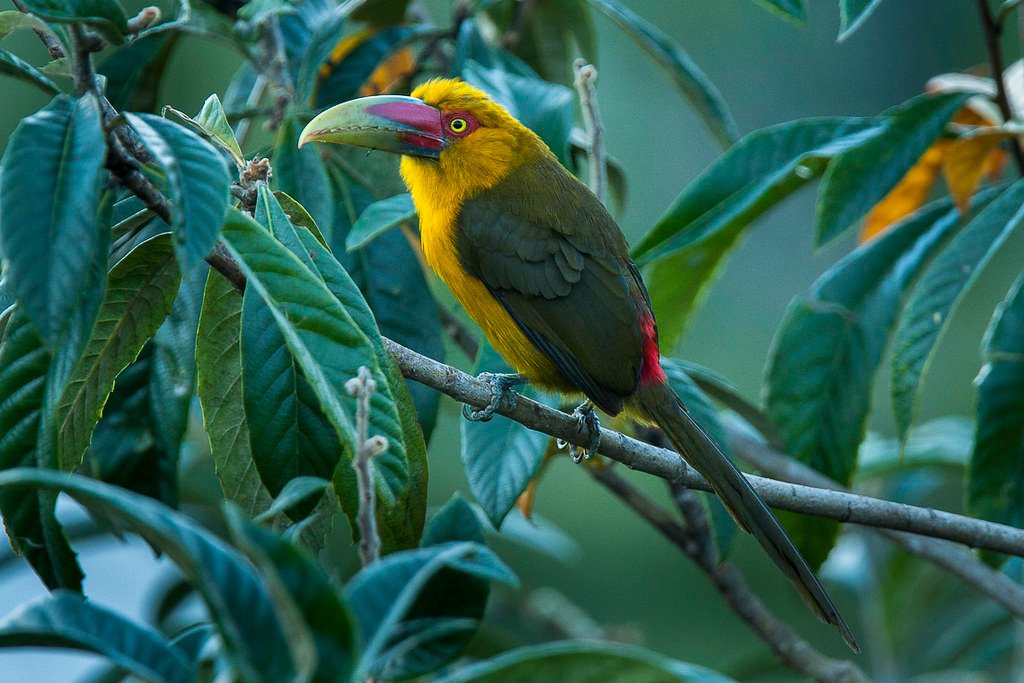
This colorful bird will astound you when you see it. Sadly, it can be challenging to witness them in their natural habitat due to the loss of their home and the dwindling population. But, if you get the chance to see them, you are in for some luck!
Physical Features And Other Characteristics
The Saffron Toucanet is also well known as the “Araçaribanana” in Portuguese, which means “banana toucanet.” This is due to their saffron yellow feathers and pale yellow, green beak. Around its bright yellow eyes, its skin is red.
They grow slightly over 2 feet long and even longer when you include their long dark grayish brown tail. It has similar features to the well-known toucan with a hefty bill and head. It can be a little difficult to recognize them by their vocalizations. However, they have quite the range that makes them unique.
Location And Environment
These birds mainly reside in the southern regions of Brazil in the Atlantic rain forests. However, you can usually find them in the humid canopies of second forests. They typically nest or make homes in abandoned woodpecker nests, so look for them in hollowed trees.
Because of the loss of their habitat, they have become less common in Argentina and Paraguay. Slowly, conservationists have been reintroducing these toucanets to areas where the birds thrived, but it has been complicated by deforestation and other factors.
Fun Fact
Saffron Toucanets have a wide range of vocalizations. This includes sounds that reassembled purring or even rattle-like calls. You will find that they can be pretty loud or even soft with their chirps and sounds.
These birds are also considered endangered not only because of their loss of habitat but because of poaching. They are often illegally captured and sold into the bird-trade industry. This is devastating to the diversity of Brazil’s rainforests.
Harpy Eagle
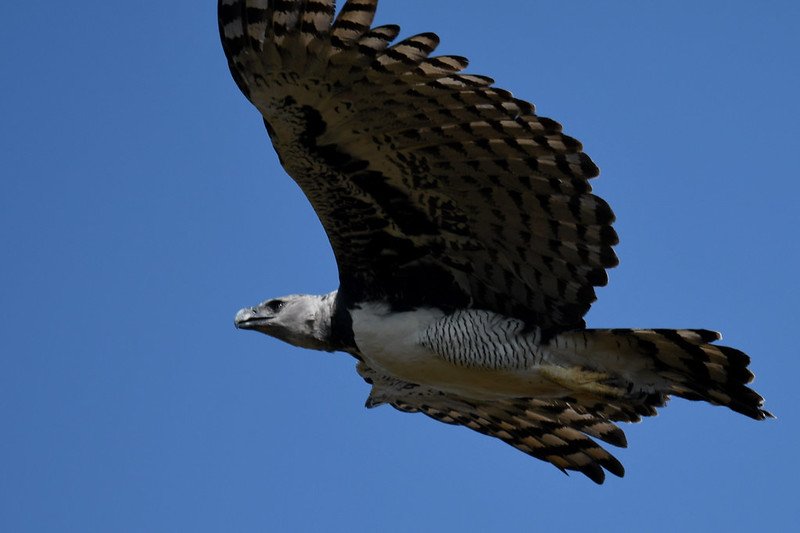
Harpy Eagles seem like a mythological creature from a fantasy novel. However, they are one of the world’s most giant and most potent eagles with a grip the same size as a grizzly bear’s claws! These are amazing creatures, but their survival is being threatened at the time.
Physical Features And Other Characteristics
Harpy Eagles are massive birds. They are longer than a full-grown adult from wing tip to wing tip. Their wingspan can reach about 2 meters. Females can grow up to two sizes more than their male counterparts, so they often attack larger prey.
They have thick, muscular legs and oversized feet that make for a great weapon as they glide down and swoop up their victims. Almost no prey is off-limits in the rainforest, even giant sloths. So you can expect them to carry anything with such a large wing span.
They aren’t colorful like many of the other rainforest birds, but this allows them to sweep in undetected. Their head has a tall, blackish-grey crest of feathers, with the rest of their body more of a dark grey, almost black color.
Location And Environment
They had originally been found in Central America and even parts of South America. Some were even seen as far south as Argentina, but due to the destruction of their habit, their population has been dwindling.
You can find some of them in Brazil in the Atlantic rainforest, but their largest population is in Central America, like Panama and Colombia. They nest within the trees where they can perch and seek out their next prey.
Fun Fact
Interestingly, the females can weigh almost twice as much as the male Harpy Eagles. This makes them the more fruitful hunter, making sense with them feeding the hatchlings. The females can be about one-third or more significant than the males.
Although they are the most powerful raptors in the world, their wings, compared to the size of their body, are not meant for traveling long distances. Instead, they tend to fly for short periods and take breaks within the height of the Amazon rainforests.
Hoatzin

This Neotropical bird is considered one of the magnificent birds of the Amazon rainforest while simultaneously being one of the weirder ones. For many reasons, it has become known as the “flying cow” of the rainforest.
Physical Features And Other Characteristics
The Hoatzins are chicken-sized birds with an orange mohawk-like crest accenting a blue face. It has a yellowish, orange underbelly topped with dark brown and red feathers. It looks similar to a colorful quail.
This bird is often compared to cows because they are ruminators. Like cows, they digest their food with the help of bacterial fermentation and have specialized sacs in their gut called “rumen.” It can take them literal days to digest their food thoroughly.
Location And Environment
Hoatzins have gone extinct in many places because of poaching and deforestation. You won’t find them in zoos very often because they don’t live long there. You can find them mainly in the Amazon rainforest in South America.
They tend to live near swampy areas or near water. They are often found in the Amazon and Orinoco river basins. They have been the closest link to dinosaurs, but it has yet to be determined where they are in the evolutionary chain when it comes to the evolution of birds.
Fun Fact
Although they are considered the “flying cows” of birds, they are not tasty to eat. People have complained that their meat is quite unpleasant. This has protected them from being hunted by humans.
When the Hoatzin chicks are first born, they have two claws on the digits of each wing. This lasts about three months before they eventually go away. These claws resemble the dinosaurs they descend from and have probably helped them survive all these years.
Banded Cotinga

The Banded Cotinga is a beautiful breed of bird that many exotic collectors like to capture. They are magnificent, and seven birds are in this genus family of Cotingas. Every one of them is striking and lovely to look at.
Physical Features And Other Characteristics
Like most animals, the male is often more striking than the female. This is due to the males being required to attract the female gaze. The males’ feathers shimmer in shades of blue and purple, making it a pleasant sight to see, while the females have a brown color.
These tiny birds are pretty shy, so if you have the chance to see them in their natural habitat, you are one of the lucky bird watchers! They have a black beak and eyes that offset their colorful feathers and tend to keep to themselves.
Location And Environment
These birds live within the Atlantic rainforest along with birds like the Saffron Toucanet and the Pin-Tailed Manakin. Because they are shy, they stay high within the rainforest’s canopy and love the humid conditions.
There are less than 1,000 birds in the rainforest as of today due to their habitat loss. It has become one of the most endangered birds within the rainforest. There have been attempts to protect areas in which they reside, but deforestation is still ongoing.
Fun Fact
There isn’t much known about these birds because they are so shy. Even the other seven birds within this genus-group have little information on them. They keep to themselves and make it difficult for scientists to study them.
Amazon Kingfisher
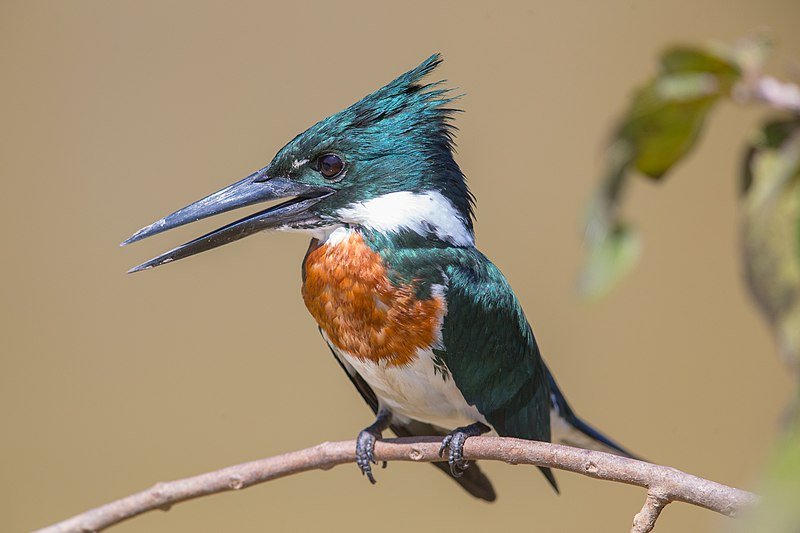
This petite, tropical bird can be located in Brazil. Males are often the most notable with their vibrant colors. They are easy to spot with their distinct characteristics but often confuse their cousin, the Green Kingfisher.
Physical Features And Other Characteristics
The male Amazon Kingfishers are what bring around the onlookers with their white undertones, dark orangish-brown chest, and green feathers on their flanks. At the same time, the females are less bright. Nevertheless, they are easily recognized by the crest of feathers on their head and slender bill.
These birds get to be only about 30 cm big even though it’s one of the larger Kingfisher species. They have stocky bodies and short legs with a fast, broad tail. Their feet are strong, which helps them last long periods when they perch in the trees.
Location And Environment
You can find these birds across the Americas, but they mainly reside in South America. These birds are unlike other breeds and usually stay within an area their entire lives. They do not migrate during the seasons.
These birds don’t make nests within the canopies but dig out tunnels. They will burrow in a chamber at the end of the tunnel where they lay their eggs. They make their homes near rivers and water masses.
Fun Fact
This species of Kingfisher is three times larger than its cousin, the Green Kingfisher. These birds also grow pretty fast. They only stay fledglings for a few days to one week before leaving the nest and fending for themselves.
Toco Toucan

You may have seen this bird species in the famous film “George of the Jungle,” as George’s sidekick. It is a well-known bird worldwide with its large beak and bright colors. In addition, it is the largest of the Toucan species, making it much more memorable.
Physical Features And Other Characteristics
Many recognize the Toco by its jet black coat, white bib, and bright blue eyes. However, the most significant part of the Toco Toucan is its large orange and yellow beak (8 inches long) that matches its large body. You definitely can’t miss them.
This toucan is exceptionally social and usually lives with others in nests. They are pretty vocal; if you see one, try talking to it. It will talk back to you. Unfortunately, they are awkward birds, unable to fly well, so they spend most of their time perched up in the boughs of the rainforest.
Location And Environment
These birds love to play at the edge of the rainforest, so you won’t find them as you go deeper. But they are sustainable in several different habitats, so you will find that deforestation is not harming them as much as some other breeds in Brazil. You can find them in tropical forests, savannas, and shrubland.
You can find them in central and southern parts of Brazil, living with roommates. There will usually be several toucans living in one single hollow. Most of the time, these hollows are created by woodpeckers and later abandoned or are naturally formed.
Fun Fact
Toucan chicks are not born with a powerful beak-like their parents. Instead, the beak grows over time as the bird develops. Their beaks, although big compared to their body, are not heavy. It is made from protein keratin and has air pockets to help keep a low mass.
Toucans can regulate their body temperature. To do this, they adjust the flow of blood to their beak. When more blood flows to their brim, they can release more heat from their body, cooling them down. To keep themselves warm, they tuck their beak under their feathers.
Jandaya Parakeet

The Jandaya Parakeet is one of the most notable parrots and is easy to identify. They are small compared to other species within their family and are quite intelligent. You won’t have a dull moment with these birds.
Physical Features And Other Characteristics
These birds are easily identifiable with their orange, green, and blue colors. In addition, they are relatively more significant than their cousin, the Green Cheeked Parakeet, reaching about 12 inches from beak to tail.
They can do acrobats due to the two toes in front and back. These extra toes allow them to hang onto objects and hang upside down. So don’t be surprised when they do a flip and say hello to you.
These birds are active and will scream and become destructive if ignored or bored. They love playtime and love to socialize. When kept in captivity, they bond with their owners and love to cuddle with them. Be prepared to have a shoulder companion.
Location And Environment
You will find that this breed is often bred in captivity, just like many other types of parakeets, but their homeland is North-Eastern Brazil. They live in woodlands and nest in hollow trees in the air.
Because they are social birds, they tend to move within a group. There can be anywhere from twelve to thirty birds in one group. They do migrate within the area, up to several miles, but they do not migrate out of Brazil.
Fun Fact
These birds can learn a few phrases, but they aren’t the best talking bird. So if you are interested one thinking they are conversationalists, they are not. However, they still have quite the charm without their words as they will love you with their whole being and can do a few tricks!
Fork-tailed Pygmy-Tyrant

Another bird on the endangered list is this tiny flycatcher. It is rare, and because of this, scientists have little information on its personality and behavior. It doesn’t help that they aren’t as colorful as many other species in Brazil and are small in size.
Physical Features And Other Characteristics
This tiny bird has a distinctive pattern: a brown head, olive body, and a forked white-tipped tail framed by a dark border. Because of such a pattern and tail, it was named “fork-tailed.”
It is pretty shy, and scientists and other birdwatchers often have trouble getting a glimpse of it. However, you will often find their calls are in a series of three, fast and high pitched. This will help you identify if one is near or not.
Location And Environment
The Fork-tailed Pygmy-tyrant is located in Southeast Brazil within the forests. They are slowly dying because this area has been harmed by deforestation. It is said that there may be less than 10,000 left out in the wild, but it is difficult to determine an exact amount.
Forest borders among dense bamboo and vines are where these creatures like to reside. The forest’s second growth is also a favorite spot of theirs. You may even find them within the leaves, feeding off insects like tiny caterpillars and katydids.
Fun Fact
This little flycatcher can survive in degraded forests, but it still isn’t the ideal conditions for them to prosper in. Little is known about them because they are so rare, and there are very few sightings, even with today’s technology.
Black-eared Fairy

The Black-eared Fairy gets its name for its tiny size. As part of the hummingbird family, they are not only small but have beautiful physical features as well. Unlike some of the other birds on this list, this one is considered a common bird instead of an endangered one.
Physical Features And Other Characteristics
These tiny birds have a striking, bright green color with black ear patches. Their underbellies are painted a bright white. They will catch your eye when you see them, but their speed can make it challenging to keep your vision on them.
They get their name not only for their beautiful color but because of how they create their nests. They will make a small nest out of plant fives and apply green moss to hide from predators. You can usually locate these nests on leaves. It is almost like a fairy sleeping on a leaf!
Location And Environment
These tiny hummingbirds live in an extensive range of tropical forests in South America. This includes a large part of northern Brazil and the Atlantic rainforest in South Brazil. In addition, they like to live in humid lowland forests and forest edges.
Although they are pretty standard, their population is decreasing. With deforestation of their habitat, they have been rapidly disappearing in the Atlantic Forest. Many organizations are trying to fight for restoration in those areas, but it has been a battle.
Fun Fact
Although these hummingbirds have a shorter bill, making it harder for them to retrieve and distribute pollen. They visit feeders, but it isn’t easy to catch them, even on a camera. Some have even said these hummingbirds will go out of their way not to get captured on camera when getting sugar water from the feeders.
Why Are These Birds Important?
These birds are considered very important to the ecosystem of Brazil, including the more common breeds. The diversity and population of the birds are a direct reflection of the quality of the environment. Therefore, when there is a decline and extinction, it means devastation to that habitat.
This Neotropical area needs to be conserved for the diversity and protection of the birds and the entire world. It provides an essential role in the homeostasis and health of the world’s environment.
The Amazon Rainforest has slowly been farmed and cut down with extensive deforestation. It converts the majority of the carbon dioxide in the atmosphere into oxygen. With deforestation and increased emissions, the atmosphere becomes more polluted.
Conclusion
Brazil holds quite the collection of birds, and you will not leave without seeing some of these on this list. They are all beautiful and unique in their way, adding to the character of this country. However, it is essential to remember that these creatures only add to the diversity and should be celebrated along with the rest of the wildlife within Brazil.
While you’re here, I think we might interest you with these:
A Guide To Birdwatching In Brazil – If you’re into learning and seeing different and exotic birds in their natural habitat, then birdwatching in Brazil is just what you need! Look at this post to find out all you need to know!
15 Reasons Why You Should Visit Ilha Grande on Your Vacation to Brazil – Ilha Grande is a gorgeous island that you should most definitely visit on your next trip to Brazil. Click and let us give you 15 reasons why you should include it in your itinerary!
Moving To Brazil With My Pet: How To Take Them – If you’re planning to move to Brazil, leaving your pet behind is not an option! Check out this post and learn everything you need to know about moving with your pet to Brazil!
Cover Photo Credit: PxHere
